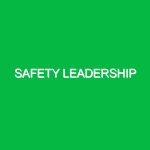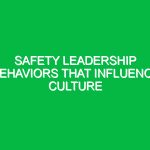In today’s fast-paced world, the importance of health, safety, and environment (HSE) practices cannot be overstated. Organizations face various risks, and ensuring a safe workplace is not just a regulatory requirement; it’s a moral obligation. Developing safety leaders at all levels is a critical strategy that empowers individuals within an organization to take ownership of safety. This article will explore the essence of cultivating safety leaders, the hazards associated with this endeavor, the necessary precautions, and the relevant regulations guiding this initiative.
The Essence of Developing Safety Leaders at All Levels
Developing safety leaders at all levels involves nurturing a culture of safety throughout an organization. It’s about instilling the belief that safety is everyone’s responsibility, not just that of the designated safety officers or managers. When each employee, from entry-level workers to upper management, is trained and engaged in safety practices, the probability of accidents and incidents diminishes significantly.
This leadership development process is not merely a training program; it’s a comprehensive approach that integrates safety into the core values of the organization. It fosters an environment where employees feel empowered to speak up about unsafe practices, suggest improvements, and lead by example. In essence, safety leadership is about creating a proactive rather than reactive safety culture.
Potential Hazards and Risks in Developing Safety Leaders
While the benefits of developing safety leaders are profound, several hazards and risks can emerge during this process. Understanding these potential pitfalls is crucial for effective implementation.
1. Lack of Engagement
One of the primary risks is a lack of engagement from employees. If team members don’t see the value of safety leadership training, they may become disinterested. This disengagement can lead to a superficial understanding of safety protocols, which may result in unsafe practices remaining unchallenged.
2. Ineffective Communication
Another significant hazard is ineffective communication. If the message surrounding safety leadership does not resonate throughout the organization, it may lead to confusion and misinterpretation of safety practices. Poor communication can breed mistrust, making employees hesitant to report safety concerns.
3. Insufficient Training
Training programs that are rushed or poorly designed can contribute to inadequate safety knowledge. If employees do not receive thorough training, their understanding of safety procedures may be superficial, leading to dangerous situations in the workplace.
4. Resistance to Change
Change is often met with resistance. Employees accustomed to a certain way of working may be reluctant to adopt new safety practices. This resistance can hinder the establishment of a safety-first culture, resulting in persistent unsafe behaviors.
Safety Precautions and Best Practices
To mitigate these hazards, organizations must implement strategic safety precautions and best practices that align with the development of safety leaders at all levels.
1. Foster a Safety Culture
Creating a robust safety culture should be a priority. This involves encouraging open communication about safety concerns and recognizing employees who contribute positively to safety practices. Celebrating safety milestones can also motivate team members to remain engaged.
2. Develop Comprehensive Training Programs
Investing in high-quality training programs is paramount. These programs should not only cover safety protocols but also focus on leadership skills, communication strategies, and problem-solving techniques. Interactive training sessions, such as workshops and simulations, can enhance engagement and retention of information.
3. Implement Regular Safety Audits
Conducting regular safety audits is a proactive approach to identify potential safety hazards and areas needing improvement. These audits should involve team members at all levels to foster ownership and accountability. The feedback gathered can inform necessary adjustments in training and safety protocols.
4. Encourage Peer-to-Peer Learning
Peer-to-peer learning can be a powerful tool in developing safety leaders. Encouraging employees to share their experiences and insights can create an environment where safety knowledge is continuously exchanged. This approach not only enhances learning but also builds camaraderie among team members.
Regulations and Standards Governing Safety Leadership Development
Several regulations and standards guide the process of developing safety leaders at all levels. Understanding these frameworks is crucial for compliance and effective implementation.
1. Occupational Safety and Health Administration (OSHA)
In the United States, OSHA sets forth regulations that require employers to maintain a safe workplace. OSHA encourages training and education, emphasizing that safety leaders must be equipped with the necessary knowledge to uphold safety standards.
2. ISO 45001
The ISO 45001 standard provides a framework for occupational health and safety management systems. It emphasizes the importance of leadership and worker participation in developing a safety culture, making it relevant for organizations looking to cultivate safety leaders.
3. National Institute for Occupational Safety and Health (NIOSH)
NIOSH conducts research and makes recommendations for preventing work-related injury and illness. Their guidelines can assist organizations in crafting effective safety leadership programs that align with best practices in the industry.
Real-Life Examples of Successful Safety Leadership Development
To illustrate the impact of developing safety leaders, consider the case of a manufacturing company that faced a high rate of workplace accidents. Management decided to invest in a comprehensive safety leadership program that focused on empowering employees at all levels.
The program included training sessions on risk assessment, emergency response procedures, and effective communication. As a result, employees began to take initiative in identifying hazards and suggesting improvements. Over time, the company saw a significant reduction in accidents and an increase in overall employee morale.
This transformation stemmed from a commitment to developing safety leaders at all levels, showcasing how effective training and engagement can lead to positive outcomes.
Conclusion
Developing safety leaders at all levels is an essential strategy for enhancing health, safety, and environmental practices within any organization. By recognizing the potential hazards associated with this development, implementing effective safety precautions, and adhering to relevant regulations, companies can cultivate a culture of safety that empowers all employees. The journey may be challenging, but the benefits of fostering safety leadership are immense—creating a safer workplace for everyone, ultimately leading to a more productive and engaged workforce.


